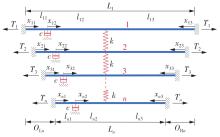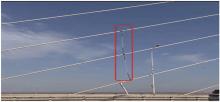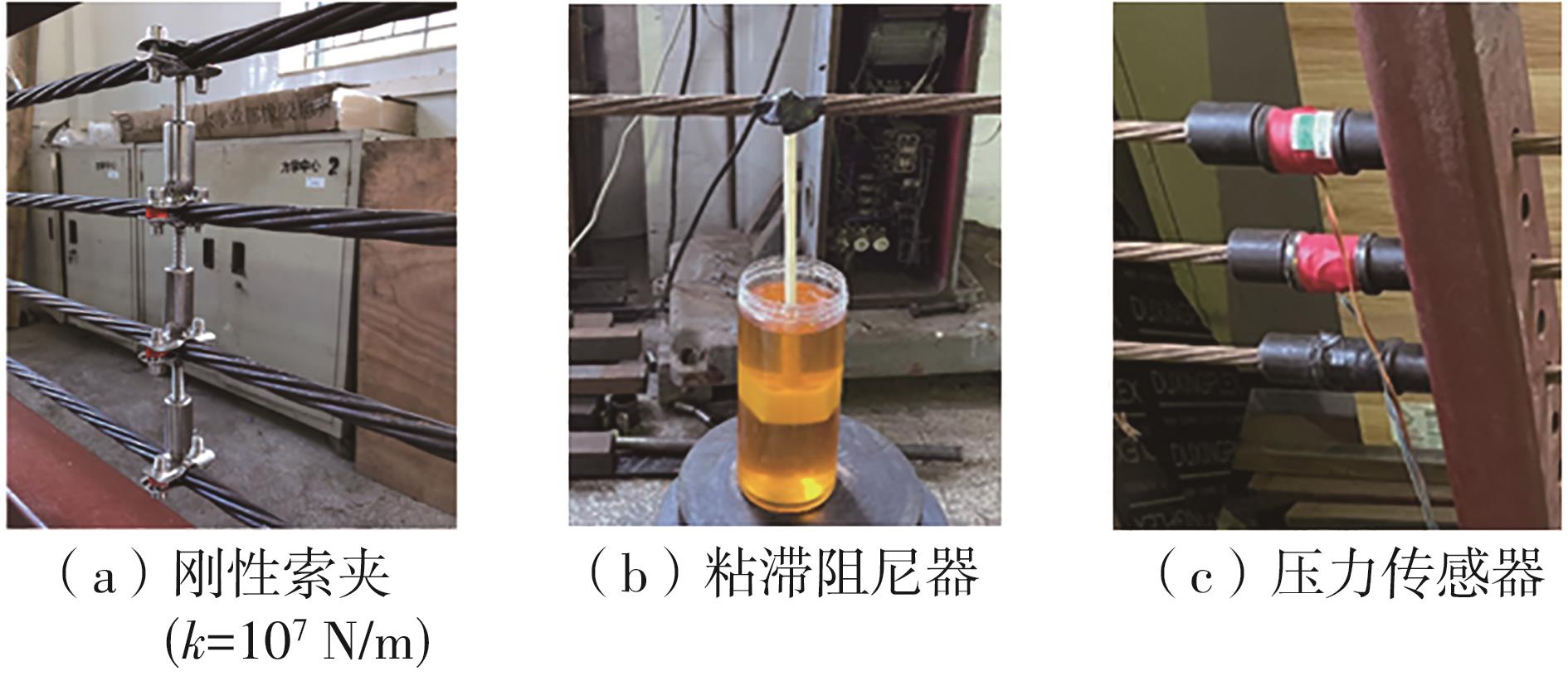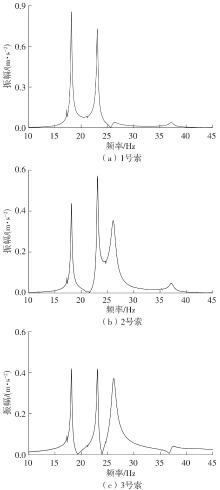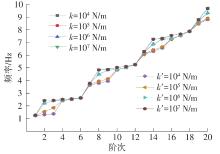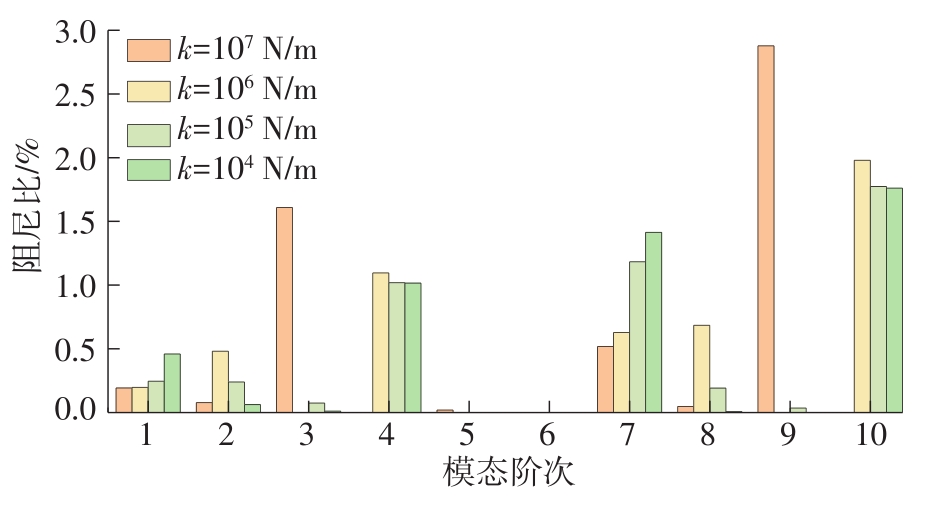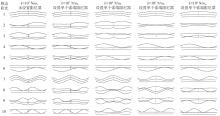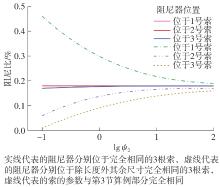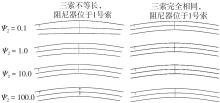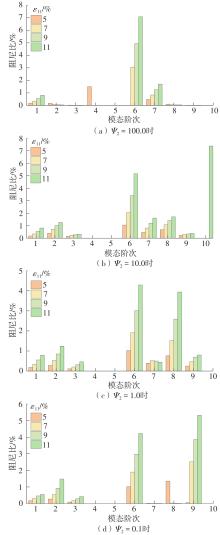Journal of South China University of Technology(Natural Science Edition) ›› 2023, Vol. 51 ›› Issue (7): 61-71.doi: 10.12141/j.issn.1000-565X.220631
Special Issue: 2023年土木建筑工程
• Architecture & Civil Engineering • Previous Articles Next Articles
Study on Natural Vibration Characteristics of Cable Network-Damper System
ZHEN Xiaoxia1 LIU Guiyuan1 DONG Chunguang2 ZHANG Zhuojie3 LI Mingyang4
- 1.School of Civil Engineering and Transportation,South China University of Technology,Guangzhou 510640,Guangdong,China
2.Poly Changda Engineering Co. Ltd. ,Guangzhou 510075,Guangdong,China
3.State Key Laboratory of Mechanical Behavior and System Safety of Traffic Engineering Structures,Shijiazhuang Tiedao University,Shijiazhuang 050043,Hebei,China
4.Foshan Transportation Science and Technology Co. Ltd. ,Foshan 528000,Guangdong,China
-
Received:2022-09-29Online:2023-07-25Published:2023-01-17 -
Contact:张卓杰(1986-),男,博士,副教授,主要从事大跨度桥梁结构理论研究。 E-mail:stdzhangzhuojie@163.com -
About author:甄晓霞(1976-),女,博士,副教授,主要从事大跨度桥梁结构动力特性及病害诊断研究。E-mail:xxzhen@scut.edu.cn -
Supported by:the National Natural Science Foundation of China(52178138);the Natural Science Foundation of Guangdong Province(2021A1515012064)
CLC Number:
Cite this article
ZHEN Xiaoxia, LIU Guiyuan, DONG Chunguang, et al. Study on Natural Vibration Characteristics of Cable Network-Damper System[J]. Journal of South China University of Technology(Natural Science Edition), 2023, 51(7): 61-71.
share this article
Table 1
Comparison of measured and calculated values of the first three-order natural vibration frequencies of the system"
| 数值类型 | 索号 | 拉力/kN | 各阶次频率/Hz | |||||
|---|---|---|---|---|---|---|---|---|
| 1阶 | 2阶 | 3阶 | ||||||
| 无阻尼 | 有阻尼 | 无阻尼 | 有阻尼 | 无阻尼 | 有阻尼 | |||
| 实测值 | 1号索 | 11.0 | 18.19 | 18.19 | 23.31 | 23.07 | 27.10 | 26.27 |
| 2号索 | 15.5 | 18.19 | 18.19 | 23.32 | 23.07 | 27.10 | 26.22 | |
| 3号索 | 20.0 | 18.19 | 18.19 | 23.31 | 23.07 | 27.10 | 26.22 | |
| 解析值 | 系统 | — | 16.87 | 16.86 | 21.26 | 21.27 | 24.96 | 24.97 |
| 仿真值1 | 系统 | — | 16.87 | 16.86 | 21.26 | 21.27 | 24.96 | 24.97 |
| 仿真值2 | 系统 | — | 18.67 | 18.69 | 23.83 | 23.84 | 27.47 | 27.47 |
Table 3
First ten-order frequencies, damping ratios and CLM values of the system"
| 模态阶次 | 频率/Hz | 设置阻尼器时的阻尼比/% | 设置阻尼器时的CLM值 | 未设置阻尼器时1)的 频率/Hz | 未设置阻尼器时的CLM值 | |||||||||
|---|---|---|---|---|---|---|---|---|---|---|---|---|---|---|
| k= 107 N/m | k= 106 N/m | k= 105 N/m | k= 104 N/m | k= 107 N/m | k= 106 N/m | k= 105 N/m | k= 104 N/m | k= 107 N/m | k= 106 N/m | k= 105 N/m | k= 104 N/m | |||
| 1 | 1.258 | 1.258 | 1.253 | 1.229 | 0.19 | 0.20 | 0.25 | 0.46 | 0 | 0.01 | 0.10 | 0.50 | 1.258 | 0 |
| 2 | 2.426 | 2.203 | 1.539 | 1.310 | 0.08 | 0.48 | 0.24 | 0.06 | 0.69 | 0.32 | 0.30 | 0.22 | 2.415 | 0.63 |
| 3 | 2.430 | 2.414 | 1.847 | 1.371 | 1.61 | 0.00 | 0.07 | 0.01 | 0.82 | 0.32 | 0.31 | 0.33 | 2.433 | 0.34 |
| 4 | 2.516 | 2.418 | 2.417 | 2.420 | 0.00 | 1.10 | 1.02 | 1.02 | 0.63 | 0.60 | 0.63 | 0.63 | 2.516 | 0.63 |
| 5 | 2.554 | 2.516 | 2.516 | 2.516 | 0.02 | 0.00 | 0.00 | 0.00 | 0.31 | 0.63 | 0.63 | 0.63 | 2.554 | 0.31 |
| 6 | 2.625 | 2.625 | 2.625 | 2.625 | 0.00 | 0.00 | 0.00 | 0.00 | 0.63 | 0.63 | 0.63 | 0.63 | 2.625 | 0.63 |
| 7 | 3.778 | 3.768 | 3.702 | 3.647 | 0.52 | 0.63 | 1.18 | 1.41 | 0.01 | 0.11 | 0.51 | 0.63 | 3.773 | 0.01 |
| 8 | 4.853 | 4.492 | 3.938 | 3.797 | 0.05 | 0.68 | 0.19 | 0.01 | 0.67 | 0.25 | 0.22 | 0.63 | 4.831 | 0.63 |
| 9 | 4.887 | 4.838 | 4.128 | 3.950 | 2.88 | 0.00 | 0.03 | 0.00 | 0.86 | 0.30 | 0.33 | 0.63 | 4.868 | 0.35 |
| 10 | 5.032 | 4.850 | 4.850 | 4.850 | 0.00 | 1.98 | 1.77 | 1.76 | 0.63 | 0.62 | 0.63 | 0.63 | 5.032 | 0.63 |
| 1 | 刘志文,沈静思,陈政清,等 .斜拉索涡激振动气动控制措施试验研究[J].振动工程学报,2021,34(3):441-451. |
| LIU Zhi-wen, SHEN Jing-si, CHEN Zheng-qing,et al .Experimental study on aerodynamic control measures for vortex-induced vibration of stay-cable[J].Journal of Vibration Engineering,2021,34(3):441-451. | |
| 2 | WANG H, TAO T, GAO Y,et al .Measurement of wind effects on a kilometer-level cable-stayed bridge during Typhoon Haikui[J].Journal of Structural Engineering,2018,144(9):04018142. |
| 3 | CHEN L, SUN L, XU Y,et al .A comparative study of multi-mode cable vibration control using viscous and viscoelastic dampers through field tests on the Sutong Bridge[J].Engineering Structures,2020,224:111226. |
| 4 | ZHOU H J, YANG X, PENG Y R,et al .Damping and frequency of twin-cables with a cross-link and a viscous damper[J].Smart Structures and Systems,2019,23(6):669-682. |
| 5 | 李东超,赵海威,杨林 .大跨度斜拉桥施工期斜拉索减振技术研究及应用[J].世界桥梁,2021,49(3):91-96. |
| LI Dongchao, ZHAO Haiwei, YANG Lin .Research and application of vibration suppression techniques for stay cables of long-span cable-stayed bridge in construction stage[J].World Bridges,2021,49(3):91-96. | |
| 6 | 汪正兴,王波,柴小鹏 .大跨度斜拉桥斜拉索阻尼减振技术研究进展[J].桥梁建设,2015,45(3):13-19. |
| WANG Zheng-xing, WANG Bo, CHAI Xiao-peng .Research advancement of damping techniques for stay cables of long span cable-stayed bridges[J].Bridge Construction,2015,45(3):13-19. | |
| 7 | 黄继民,林志兴,项海帆 .大跨度斜拉桥中的辅助索减振研究[C]∥中国土木工程学会市政工程分会2000年学术年会论文集.西安:中国土木工程学会市政工程分会,2000:374-385. |
| 8 | AHMAD J .In-plane dynamic behavior of conventional and hybrid cable network systems on cable-stayed bridges[D].Windsor:University of Windsor,2016. |
| 9 | AHMAD J, CHENG S, GHRIB F .Combined effect of external damper and cross-tie on the modal response of hybrid two-cable networks[J].Journal of Sound and Vibration,2018,417:132-148. |
| 10 | CHEN W, ZHANG Z, ZHEN X,et al .Effect of bending stiffness on the in-plane free vibration characteristics of a cable network[J].Journal of Mechanical Science and Technology,2020,34(11):4439-4463. |
| 11 | 李明阳,甄晓霞,陈炜,等 .大跨度斜拉桥辅助索对索网系统面内自由振动特性的影响研究[J].铁道标准设计,2022,66(2):54-60. |
| LI Mingyang, ZHEN Xiaoxia, CHEN Wei,et al .Effect of cross-ties on the in-plane free vibration characteristics of cable network of long-span cable-stayed bridges[J].Journal of Railway Standard Desgin,2022,66(2):54-60. | |
| 12 | 张卓杰,谷利雄,王东强,等 .刚性耦合对多索股结构自振特性的影响[J].铁道学报,2021,43(7):153-160. |
| ZHANG Zhuojie, GU Lixiong, WANG Dongqiang,et al .Influence of rigid coupling on natural vibration characteristics of multi-strand cables[J].Journal of the China Railway Society,2021,43(7):153-160. | |
| 13 | 周亚刚 .斜拉索-辅助索系统动力特性和减振研究[D].上海:同济大学,2007. |
| 14 | CARACOGLIA L, JONES N P .In-plane dynamic behavior of cable networks.Part 1:formulation and basic solutions[J].Journal of Sound and Vibration,2005,279(3):969-991. |
| 15 | CARACOGLIA L, JONES N P .Passive hybrid technique for the vibration mitigation of systems of interconnected stays[J].Journal of Sound and Vibration,2007,307(3):849-864. |
| 16 | 冯立燕 .桥梁斜拉索-阻尼型索网减振体系研究[D].哈尔滨:哈尔滨工业大学,2012. |
| 17 | 李建立 .桥梁斜拉索-阻尼型索网减振体系的有限元分析[D].哈尔滨:哈尔滨工业大学,2013. |
| 18 | 周现宝 .形状记忆合金辅助索-拉索系统动力特性研究[D].深圳:深圳大学,2019. |
| 19 | 单德山,董俊,刘昕玥,等 .具有减震器的吊杆施工期索力识别[J].中国公路学报,2015,28(8):31-39. |
| SHAN De-shan, DONG Jun, LIU Xin-yue,et al .Tension identification of suspender with damper under construction[J].China Journal of Highway and Transport,2015,28(8):31-39. | |
| 20 | ZHOU H, ZHOU X, YAO G,et al .Free vibration of two taut cables interconnected by a damper[J].Structural Control and Health Monitoring,2019,26(10):2423 |
| 21 | 李寿英,曾庆宇,王世峰,等 .阻尼器对悬索桥双吊索减振效果的理论研究[J].工程力学,2018,35(3):186-192,226. |
| LI Shou-ying, ZENG Qing-yu, WANG Shi-feng,et al .Theoretical investigation for the effectiveness of the dampers installed between the hangers of suspension bridges[J].Engineering Mechanics,2018,35(3):186-192,226. | |
| 22 | HAN F, DENG Z, DAN D .A unified method for in-plane vibration analysis of double-beam systems with translational springs[J].Journal of Sound and Vibration,2022,534:117042. |
| 23 | 陈炜,王荣辉,周浩恩,等 .考虑抗弯刚度的耦合吊索自振特性研究[J].华南理工大学学报(自然科学版),2020,48(7):143-154. |
| CHEN Wei, WANG Ronghui, ZHOU Haoen,et al .Research on natural vibration characteristics of coupling hangers considering bending stiffness[J].Journal of South China University of Technology (Natural Science Edition),2020,48(7):143-154. |
| [1] | CHEN Shumei, TANG Hongjan, HUANG Hui, et al. Performance of Magnetorheological Damper with Shear-Extrusion Hybrid Mode [J]. Journal of South China University of Technology (Natural Science Edition), 2021, 49(2): 140-150. |
| [2] | ZHENG Yifeng QIAN Shengyu . Study on the application of viscous dampers and steel dampers to bridge transverse vibration control [J]. Journal of South China University of Technology(Natural Science Edition), 2021, 49(12): 89-100. |
| [3] | DING Yu, CHEN Xiaobin, WANG Xuan, et al. Experimental Investigation into Dynamic Elastic Modulus and Damping Ratio in Transient Saturated Zone of Red Sandstone Residual Soil Subgrade [J]. Journal of South China University of Technology (Natural Science Edition), 2019, 47(11): 130-139. |
| [4] |
CHENG Hao WANG Xuan ZHANG Jiasheng WANG Qiyun.
Effects of Roughness on Cyclic Shear Behavior of Red Clay-Concrete Interface
|
| [5] | LI Guojie LI Liping Subhash Rakheja SHANGGUAN Wenbin . Research on dynamic characteristics of a magneto-rheological damper featuring piston bypass holes [J]. Journal of South China University of Technology (Natural Science Edition), 2018, 46(12): 66-73,102. |
| [6] |
Zha Xiao-xiong Zuo Yang Liu Le Wang Xin-jie.
Analysis of Mechanical Properties of Container Structure Under Earthquake Action
[J]. Journal of South China University of Technology (Natural Science Edition), 2015, 43(7): 92-99.
|
| [7] | Qiu Zhi-cheng Wu Chuan-jian. Hierarchical Fuzzy Vibration Control of Rotating Double Flexible Piezoelectric Beams [J]. Journal of South China University of Technology (Natural Science Edition), 2015, 43(10): 100-107. |
| [8] | Qiu Zhi-cheng Ling De-fang. Nonlinear Vibration Control of Piezoelectric Cantilever Plate [J]. Journal of South China University of Technology(Natural Science Edition), 2012, 40(11): 45-51. |
| [9] | Li Peng-fei Yuan Quan Guo Meng Yao Qian-feng. Experimental Investigation into Hysteretic Performance of Normal-Strength Steel Dampers [J]. Journal of South China University of Technology (Natural Science Edition), 2011, 39(6): 148-154. |
| [10] | Xie Zhuo-wei Shi Ming-li Wang Bin Qiu Zhi-cheng. Vibration Control of Flexible Translating Manipulator with Pneumatic Driving [J]. Journal of South China University of Technology (Natural Science Edition), 2011, 39(4): 62-65,104. |
| [11] | Sun Shu-min Xu Li-ming. Control of Random Wave Response of Wave-Permeable Breakwater Using TLD [J]. Journal of South China University of Technology (Natural Science Edition), 2007, 35(2): 75-78. |
| Viewed | ||||||
|
Full text |
|
|||||
|
Abstract |
|
|||||
